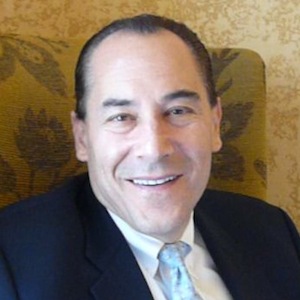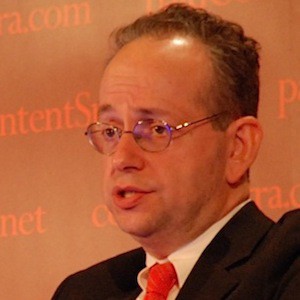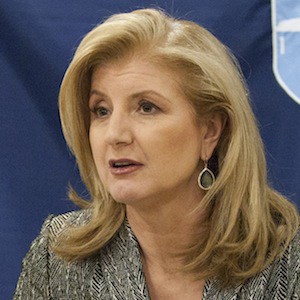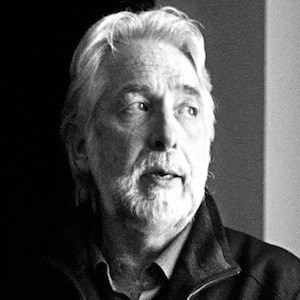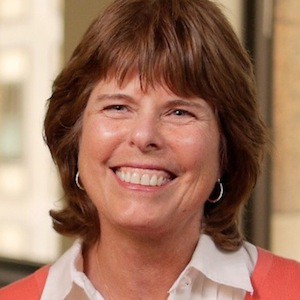Martin Nisenholtz: It’s April 5th. We’re in New York. Martin Nisenholtz is interviewing Tom Rogers on the MSNBC deal. Tom, let’s start. Let’s go back to the MSNBC formation. One of the things that we’ve learned I’m not sure you were aware of this or not or whether it’s even true, but we’ve learned it from interviewing the folks at CNN is that, initially, Bill Gates wanted to do the deal with CNN. Is that something that you recall? Did you know about that or not?
Tom Rogers: I would say that Microsoft and CNN were having conversations at the time about how they might work together. We had had some contact with Microsoft. We felt that if they were interested in that kind of alliance, NBC could create a better opportunity for Microsoft to move forward in the media space than CNN could. We put together an approach to Microsoft. I remember that Andy Lack, then president of NBC News, and myself sat down with Bill Gates and basically pitched him on the assets and strengths of NBC and how a partnership between Microsoft and NBC might be put together. Obviously we were successful in getting him to think that we were a better way to go than CNN.
Martin: Why did you want to work with Microsoft?
Tom: There were two things that really drove that. One was, it was clear that we needed to have a broader catalyst for driving into new media. We had a number of Internet investments. NBC had been very aggressive, more aggressive than the other networks in driving into cable and cable news, and then international channel development. Our next great frontier was new media and the Internet frontier. We looked at Microsoft as a partner with a substantial amount of Internet traffic, a substantial amount of financial resource, and a substantial ambition to move forward in the media in some way. We were always about finding the right partners that could catalyze our involvements in a new area better. That was one.
Two, we very much were looking to take a cable channel asset we had, which had been started as “America’s Talking,” and had been the vehicle through which retransmission consent, when it was initiated, was essentially paid for by cable operators; meaning, when retransmission consent as an FCC policy began,
I made the decision, as head on NBC Cable at the time, that we were not likely to get direct cash payments for our broadcast station and network assets, but that the cable industry would be amenable to using a cable channel as consideration in the form of distribution and distribution fee payments.
We had created a vehicle called “America’s Talking” that had served as our mechanism to negotiate with the cable operators. At the time we crafted that channel, we devised a channel description that cable operators agreed to that gave us flexibility in terms of the balance of news and talk that could be produced on the channel.
It certainly gave us a vehicle around which we could have a discussion about creating a more full fledged news channel. We had created CNBC and a business news channel, but had not had a general news platform.
We knew that Microsoft was interested in that very platform because of the discussions they had had with CNN. We put this forward as a way they could have it and own 50 percent of it, and we would bring the full resources of NBC News to it. We were also looking for a partner that could help us fund and develop a broad news channel.
The third piece of this was that we were very interested in how traditional news and Internet news could be fused into a single franchise where the two could be strengthened by some joint undertaking. The brand would stand for both forms of news. A viewer or user would be able to benefit by being able to go back and forth and understand how the two pieces fit together.
That was the most revolutionary part. That was the part that probably, of the various elements and putting this together, was the rockiest, but that was very much the formative thinking around it.
Martin: One of the things that keeps coming up in our conversations is this notion that news organizations just didn’t really understand the technology. It sounds to me like part of your rationale was meant to solve that problem.
Tom: We were being pretty ambitious. We were doing two things at once bringing a broadcast network operation into cable news, which, in and of itself, in the mid ’90s, was a heavy lift; and making sure that the likes of a Tom Brokaw, Brian Williams, Tim Russert at the time were indicating their support and enthusiasm for it so we could get the spirit of the news organization behind it. At that point, CNN was developed enough and credible enough that people understood that getting a shot at a cable news vehicle was a good thing.
Martin: But, to be clear, Fox had not yet launched.
Tom: Fox had not yet launched. CNBC was about six years old. CNBC, in its inception within NBC, had had a much rockier road in terms of a cultural embrace. Here was an opportunity, one, to do that, at the same time do it with a partner, which was a somewhat different undertaking. We were the managing partner of the cable side, Microsoft was the managing partner of the Internet side, yet there was a great deal of operational discussion about how the two could be fused to strengthen both sides of the news equation.
There were a lot of new elements here. Cable news was new. A highly produced Internet news franchise was new. Fusing the two was certainly new. There was a very ambitious lift to take place at once, all within the umbrella of a brand new partnership.
Martin: Fair to say too ambitious, maybe, in retrospect?
Tom: I would say that MSNBC developed into a major brand for a long time. I don’t know the latest ratings now, but with the traffic from MSN, was the leading news site in terms of traffic for a great deal of time, with what was a very well regarded breadth of content. I think it certainly achieved an awful lot of metrics there that were signs of real success. The cable news side certain got the cultural embrace from NBC News, which was successful. It took longer for the ratings to come about. MSNBC obviously has morphed over the years into something different than it was originally anticipated, and was able to establish NBC News as the leading network in cable news between a business news franchise and a general news and talk franchise.
The piece that was the most difficult was how do you fuse those two under a single brand. Not simply applying the brand to both that was achieved successfully, and the brand had a great deal of recognition but strengthen both sides by the fact that both new media, Internet news elements existed and cable news elements existed under a single umbrella. That part had some interesting attempts. I think it’s fair to say that that was the part that was the slowest to come about.
And then, past my time because I left NBC in 1999, essentially four years or so after it launched, there were enough friction that I think developed between the Microsoft and NBC partnership that the kind of things that you would need to really bring about how a television franchise and an Internet news franchise could strengthen each other by a close working relationship.
That friction, from what I understand, got in the way of that really developing. A lot of those initial plans were abandoned. Both sides worked to develop the strength of their own within their own medium, and both continued to be reasonably successful at doing that. But the notion of a fused cable news and Internet news franchise symbiotically existing to strengthen each other through the interactivity one would constantly have between the two pieces never fully came to fruition.
Martin: Let’s talk about the business model for just a moment. I remember very distinctly in that era that for the first time, newspapers were colliding directly with cable operators and broadcasters and entrepreneurs like the Yahoo folks. We were all thrown into this one world wide web environment at once. Some of us had histories of charging for content. Others of us had histories of having subsidies, the cable folks, and others were pure broadcast folks with advertising alone.
Did you ever think about at the time the idea that it might be a good idea to charge for the service given that there were no cable subsidies? In other words, you were committing to a one revenue stream business. As a cable guy, you must have thought, “Don’t like this as much as cable,” to be blunt.
Tom: The dual revenue stream model that cable had in the subscriber fees that we had won for MSNBC through the retransmission consent negotiations gave us a great deal of confidence that ultimately that was a very strong business model. We had seen it develop in CNBC. We were owners of other cable channels. It was clear by the mid ’90s that was a really powerful business model. It’s only become more so.
Our view was that it was going to take a much longer period of time for the business model around Internet news to develop. Microsoft had a much more aggressive vision of how quickly that would come about. I think that when they signed up for the deal, they expected the near term economic return to be much more favorable to them than it ended up being.
That didn’t really disappoint our expectations. I think it did disappoint their expectations, how much longer that model took to develop.
No, we didn’t really consider charging a subscription fee. Our view was that the strength of the MSNBC franchise would come from the breadth of its availability and access as a television and Internet based news source that one could come to at any time for any breaking news, for analysis and commentary across almost any subject. Our goal there was for it to complement and strengthen by its association with the cable news side, which we had a great deal of confidence in the economic model.
Our view of that deal and how the deal was structured was clearly driven off of our optimistic view of cable, very long term view of what it would take for the Internet. Microsoft had a very bullish, near term view of the Internet. They were not as enraptured by what the cable economics might look like.
Those disappointed expectations had something to do with the souring of the relationship with MSNBC. Ultimately, years later, that partnership dissolved.
Martin: As someone very famous once said, “It’s easy to connect the dots looking backwards.” That’s fine. With that caveat, do you think it was a mistake for the industry to embrace this broadcast model, this free model, at the outset? Would it have been a different industry had that not happened? Had people, more or less, not in any kind of collusive way, but just in the natural scheme of business, said, “This is an Internet site that’s going to cost a lot of money to create over time. We think we need to have more than one revenue stream.”
Tom: Yes and no. I think that there were clearly opportunities to create some subscription elements in the magazine industry, for instance. The idea that the exact same content was put up for free for magazines that required subscriptions or newsstand sales. There wasn’t any particular means by which you could financially benefit by providing the same content on a free basis. There were ways that one could have created stronger communities that either drove higher ad sales or select sources of information that might be more available on a subscription basis. There was a lot of not very well thought out thinking for many parts of the media industry when it came to how that could be implemented.
If you’re specifically talking about MSNBC, NBC News existed as a single source of support of information. It was advertising only where the model was “get it out as broadly as possible.” Cable allowed us to perfect that model some by virtue of its dual revenue stream, but Internet advertising only was consistent with the core nature of how the broadcast news model had developed.
I think that what was not necessarily thought through as well as it could have been is that the major source of support for broadcast news on television came with some players willing to put some pretty big bucks behind that franchise, which you saw on the “Today” show and “Nightly News” and other places where you’d see major investments in advertising on news.
The way the Internet side was sold was “take any advertiser that will come.” No deal was too small. You know the whole story of ratcheting down the CPMs of Internet news and information. There probably should have been far more care given to how much value is being delivered to the core advertisers, limiting one’s rights to be able to promote and advertise against this whole new audience that was being brought in.
Not devalue it by essentially subjecting it to a whole different set of dynamics in a totally lower priced advertising marketplace, but figuring out a way to be more patient about how the guys with the big bucks who were supporting big news, big names, big shows, big personalities could be brought in on an exclusive basis to the big audiences that they’d be happy to have reached and paid for if it had been part of their broader package that they were uniquely getting by virtue of the fact that they were television advertisers.
I think that that piece of it probably was not as well thought through as it should have been.
Martin: Part of the promise of that joint venture, as I remember it, was that by bridging to cable…It was very early. It was a narrowband world, a desktop world, no smart phones. A lot of the monitors on desktops weren’t even in color. But it was visionary in the sense that you had the promise of bringing video to the web in a news context. How do you feel, in retrospect, about that? Did it develop in a way you thought it would, or has it not developed in a meaningful way? Interestingly, now that you’re with TiVo, it’s an interesting platform to look not only backwards at MSNBC but look forward as well.
Tom: The guts of our pitch to Microsoft in terms of how their ambitions and vision for how the Internet was going to develop and the assets that NBC had had an awful lot to do with the exploitation of video on the web. In fact, one of the key things that I remember Andy Lack and myself pitching to Bill Gates was this enormous archive going back to 1948 of every major news event that had occurred that NBC news had the video for. We were willing to provide the Internet rights for that video to be exploited in an MSNBC online context.
The constant renewal of additional news sources from NBC news, from CNBC, from MSNBC could be a phenomenal way of organizing on demand, more personalized news content that would make news and information in video form far more usable for the viewer than its broad broadcast done over the network.
Martin: That hasn’t developed even to this day.
Tom: No. I would say that that was not given attention the way it should have, even though it was a core part of the initial thrust. Part of that was business model. Part of it was, is the advertising support for it there? Part of it was, is that ahead of where the marketplace is? It is a little more confounding that today, with the comfort level that people have in organizing their own news packages and more personalized views of what is going on, it is not a whole lot easier to take a vast video resource that includes what’s going on and then context and background based on archival information that can give you an immediate context for anything that’s breaking news. This is what has already happened. Putting it all together and packaging it more easily.
We certainly view what TiVo is doing today, which is, how do you get people the best of what’s out there when you have infinite content choice and putting it together in a highly personalized way. Part of what we deliver but part of the issue is, the great banks of news and information content haven’t yet been organized in an on demand fashion that can take full advantage of the technology that people like us have.
Martin: It’s interesting. I’m renting an apartment in Cambridge. I have Internet access, but I didn’t subscribe to cable just because it’s very temporary and I’m not there that much. I went onto the web and I thought, “I’m going to find an on demand news source that I can just look at.” There’s nothing there because, I guess, the cable relationships preclude that and, for whatever reason, the broadcasters haven’t re purposed to…Their relationships may preclude it as well. There’s just no Internet news at this point that you can pull up on demand.
Tom: The individual news sites have embedded video in an awful lot of their stories, both some that have cable or broadcast franchises and those that don’t. What they don’t have is the ability to easily pull out your areas of interest, put that together in your own personalized broadcast, and be able to create your own news show from, if the archive’s big enough, a single source or, more importantly, from multiple sources. That really has not yet developed. What we see at TiVo, all video is going “get any content you want on demand wherever you want it, whenever you want it.” The metadata tagging along with the retrieval capability will certainly happen so that what I just described and what was a key part of that MSNBC vision will certainly come to light. But you’re right, it is not there for the consumer in any kind of easy form today.
Martin: When will it be? Do you have a clue?
Tom: I see where we are today. Everything about customizing and personalizing the experience and what we do today. We probably deliver for a TiVo customer seven, eight million pieces of entertainment content that ranges across everything. The ability to customize and personalize that is all about the metadata you have that tags it what it is, what category, what does it relate to, and then what your own personal interests are and, increasingly, your social network’s interests as a form of recommendation. You pull all of that together to present a unique dashboard just for that user of what they would care about.
I think we’re seeing our ability to perfect that ingestion and massaging of the data in a way that you could really put together that highly personalized video news content in the next few years. That won’t be a foreign concept.
Martin: Do you think that gets provided by entrepreneurs, by existing incumbent players, or both?
Tom: To make it broadly available, you’re going to need probably an existing player who’s providing software throughout the cable world like we are, to weave that through the bowels of some pretty difficult plumbing that cable operators have to make that broadly available. My guess is, there’ll be some entrepreneurs in there that help in some way to facilitate some piece of the chain. Undoubtedly, it will require the great providers of video, news, and information and their deep archives to be part of that, as well. I imagine it will pull from all those sectors.
Martin: The last question before we quit. My colleague, John Huey, has this metaphor. If you go back 30 years, there’s this very, let’s say, vicious tide that begins to take shape with the development of digital and certainly with the big bang of the web. Then there are the swimmers who have to navigate their way. The news industry is not, in general, in great shape. I’m talking about the institutional news industry. Can you identify any single decision or set of decisions that you think might have changed the course of that tide, in retrospect? In other words, was this an inevitable tide that was going to bring down these swimmers, or could the individual swimmers have controlled the tide a little bit better?
Tom: You mean the force of…
Martin: The force of technology is the tide. In other words, it’s this inexorable, almost a force of nature occurring to what is a traditional institutional journalism process. Whether that process is at a broadcast network or at a cable company or at a newspaper or magazine, it’s this notion of Internet protocol seeping in. The idea in the newspaper industry. The things like Craig’s List come about. Craig Newmark didn’t come in to disrupt the newspaper industry. He just wanted to sell couches in San Francisco to his friends. He wanted to create a platform to sell couches. It’s this almost drive by shooting, not to mix metaphors, that occurs.
Tom: I don’t think there’s any doubt that when you look at…Having been in both the print industry, the video industry, and the more broadly new technology industries, and you look at how each have handled the onslaught of technology, or the wave as you say, the video world has handled it much better than the print world. By virtue of that, it’s hard to say that individual players individual companies making decisions differently or industries making decisions differently can affect how the tides play out.
Martin: Can you be a little more specific? How did the video industry…? Aside from the fact that there’s a cable infrastructure that locks people into that today. 10 years from now, we could be sitting here, and that would be a thing of the past. What specifically do you mean?
Tom: Broadcast network viewing has gone through all the erosion, in some instances more the erosion, than print has, but the model’s been able to be sustained through figuring out different ways to exploit the creation of content, be there sister cable channels, video on demand windows, over the top aggregators, or other ways that the notion of technology is going to provide new and different ways for people to access content. The fact that that exists in and of itself doesn’t mean that the model for the players providing that content has to be destroyed. I’d be the first to admit that broadcast and cable players have made some missteps, haven’t moved as quickly as they should, and right now have their own set of threats from how quickly over the top might develop and a la carte programming access and some other things which could provide much more serious threats to their models than anything that has developed so far.
Over the last 15 years or so, they have managed that transition incredibly better than the print side did. I would argue there were a lot of things that might have been done differently, that might have changed the ability of the print model to grow with technology as opposed to have been so undermined from it.
Martin: Can you think of one or two things? I think it would be very interesting to get your thoughts about what one or two of those things might have been, given that you ran PriMedia, which was a print.
Tom: One of the obvious ones, which is a bit of a head scratcher today, is that getting magazines to a form that can be easily digested, conveniently digested in digital form was a much bigger struggle than it should have been. iPads have been around for a while now, which arguably finally created the best way for a digital transition to something that takes advantage of publications that are heavy with imagery. The magazine industry created something called Next Issue. I find almost no magazine subscriber is aware of what “Next Issue” is, yet it is owned by Time, Condé Nast, Hearst, Meredith, and others. All the great magazines are available at a monthly subscription price that gives unbelievable convenience to the subscriber to be able to enjoy a magazine experience that’s unparalleled from anything the magazine industry has previously developed.
You don’t know about it. You don’t hear about it. It’s a good model. It looks like it’s a subscription based model that helps these guys, that preserves the advertising. It gets rid of all the overhead paper, distribution, and the excess newsstand sales cost that gets them out of unprofitable subscriptions and turns it into profitable subscriptions.
Yet here’s an industry that still doesn’t seem to be able to embrace that digital future. That’s a very different approach than the video guys, who certainly aren’t models of always high speed action, but certainly have been able to stay enough ahead of technological change to not have their models so fully undermined.
